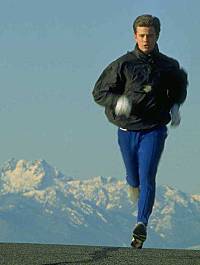 |
he doesn't burn as many calories as he would riding a horse at a trot. And he doesn't have as much fun, either! |
Q&A Questions and Answers:
I have a question. I just bought my horse, Scooter, a month ago. I love horses and have all my life, but I have never had the means {land, money, etc.} to own one.
A little over a year ago we moved to the country and I finally got my horse. I never had any real experiance, just trail rides, and only about four of those in my 28 years. Since we moved I have met a great friend who owns horses and let me ride with him some. I also went to work in a stable to learn more about horses before I bought mine. I am confident enough about the knowledge I have learned that I will be able to take good care of my horse.
What I don't seem to have as much confidence in is my ability to get in sync with my horse at a trot and canter. I do trot and canter him, thinking "practice makes perfect" but I feel I bounce in the saddle too much. Are there any tips you could give me that might help me out? My horse is a 21-year-old quarter horse gelding, if that makes any difference.
Thanks a lot.
English-style riders will tell you that you need to learn to post in order to take much of the bounce out of the trot. Unfortunately, that only works for short rides. Western riders may have to endure hours in the saddle, and therefore need to learn how to "sit the trot."
Practice does indeed make perfect. To ride correctly will require muscles you don't normally use a lot. Even riding at a walk will help you build that strength. Be sure to ride with your weight on the balls of your feet. After just a few days of not riding it may take me an hour or two before I feel like I'm really riding well. We're talking about a rather athletic activity here, and you can't expect to just jump into the saddle and perform like a super-star. (Remember, riding a horse at a trot for 15 minutes burns more calories than jogging for 15 minutes.) In my Cowboy Bob's Cowboy Calisthenics I have some exercises that you can do at home that will help you build the muscle power to ride well.
Make full use of your natural "shock absorbers." The place you don't want to take most of the shock is your rear end - unless, of course, you enjoy getting spanked non-stop for an hour or two! Building the muscles around your knees, thighs and calves will allow you to more effectively absorb much of the bounce. The third, and in some ways most effective shock absorber is one that most people seem totally unaware of: the ankle. I constantly get after my students to ride with their heels lower than their toes. Part of the reason is safety - keeping your heels down reduces the risk of your foot slipping into the stirrup and getting caught. There is also a tremendous amount of flex in your ankle. That, coupled with muscular strength in your foot, ankle, and lower leg, will go a long way toward smoothing out the bounce.
Willy doesn't usually canter; he naturally moves right into a full-bore, ground-eating, put any racehorse to shame, all-out rack. It is his smoothest gait, but it took a while for me to figure out how to ride it. The best description I've figured out is that I imagine the stirrup leathers are made of rubber and I'm pumping them up and down with my legs. This may not make any sense to you, but my point is that I just had to ride him and try various styles until I found something that worked for both of us -- where I was truly riding with him; not just ON him.
Finally, remember the advice the doctor gave to the man who said, "It hurts every time I do this." The wise physician replied, "Then don't do that." Saddlebreds have another natural gait variously called a pace or fast-walk. It's like a very choppy trot. There is simply no way to ride it smoothly. Therefore, I just try to avoid it. Sometimes I can't, and it nearly shakes me to death. I've learned to deal with it and shift gears as soon as possible.
 |
he doesn't burn as many calories as he would riding a horse at a trot. And he doesn't have as much fun, either! |
![]() Return to Questions and Answers Index
Return to Questions and Answers Index
![]() Return to the "Learning More About Horses..." page
Return to the "Learning More About Horses..." page
COPYRIGHT © 1999-2004 BOB LEMEN, GRAND RAPIDS,
MINNESOTA. ALL RIGHTS RESERVED.
Jogger photo © 1999 Nova Development Corp. Used under license.
The contents of this document are not for reproduction.